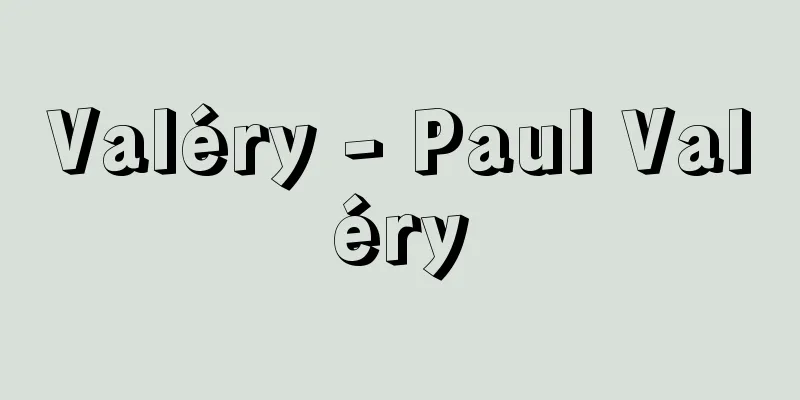Valéry - Paul Valéry

|
French poet, critic and thinker. Born on October 30th as the second son of a customs inspector in the port town of Sète in southern France. His mother is Italian. A precocious and sensitive literary boy, he began writing poetry at the age of 13 under the influence of Hugo, Baudelaire and the Sympathetic School. He was shocked when he discovered the poetry of Mallarmé and Rimbaud at the age of 18 or 19, and around the same time he was in love with an older woman he saw on the street. His feelings of despair and frustration about his poetry grew stronger, and he fell into an inner crisis around 1892. In the three-way battle between "inner weakness," "runaway emotions," and "arrogant consciousness," he regarded the thoughts and impulses that tormented him as equal mental phenomena, and by unraveling their mechanisms, he attempted to escape the crisis by fashioning himself into a transparent and rigid being. Furthermore, it aims to reach a state where everything is possible and no creative acts are necessary. [Toru Shimizu June 17, 2015] From "Cahier" to "Young Parc"After this "intellectual coup," he settled in Paris in 1894 and began to keep notes to classify and explain his own mental phenomena using mathematical methods. This resulted in the Cahiers (261 volumes, about 30,000 pages), which he continued to write throughout his life. He also wrote "Introduction to the Method of Leonardo da Vinci" (1895) and the novel "An Evening with Monsieur Teste" (1896), which were based on his own ideal image. He worked for the Ministry of the Army to make a living, and became friends with Mallarmé and others, but he distanced himself from literary production. After his marriage in 1900, he made a living as a personal secretary and devoted himself to contemplation. During this period, the subject of his Cahiers was narrowed down to measuring the interrelationships between "mental things" and "physical things," and in 1910 he wrote that he had "reached a certain maturity." By chance, his old friend Gide asked him to publish some old poems, which prompted him to start writing poetry again. He continued to write and revise his poems as an inner resistance to World War I and the premonition of the end of the world, culminating in the long poem "The Young Parc" (1917). This work brought him instant attention, and he subsequently published many poems with a mannerist attitude, freely using classical and modern poetic techniques from Racine to Mallarmé. These were collected in the collection "Enchantment" (1922), establishing his reputation as a great poet. In 1920, he met Catherine Pozzi (1882-1934), a talented woman 11 years his junior, and the two soon became involved in an ecstatic sexual relationship. The erotic elements that had been repressed in his youth were returning through the process of maturing his thoughts and creating poetic language, and the experience of love during this period gave him a glimpse of the supreme state of total exchange and fusion of the mind and the erotic. This love quickly turned into an intellectual and sensual passion, alternating with anxiety and anguish, and continued for about eight years, tormenting both of them. As a resistance to the emotional upheaval and anguish of this time, he wrote the dialogues Eupalinos (1921) and Soul and Dance (1922). Thus, while overcoming the crisis through self-analysis and the creation of works, he established a methodology for delving into the integration of the mind and the erotic based on physicality through the experience of love, and for achieving total self-completion. Thereafter, he further developed the theme of inner crisis and overcoming it through his relationships with Renée Vautier (1898-1991) from 1931 to 1932, and Jeanne Loviton (1903-1996) from 1938 to 1944, resulting in works such as the dialogue Les Persétats (1932). [Toru Shimizu June 17, 2015] Glorious later lifeFrom 1922 onwards, Valéry devoted himself to writing, and was active in critical writing in a variety of fields, including literature, art, philosophy and politics, in response to requests. His clear critiques, written in an analytical and somewhat pedantic style, were highly praised, and his work was collected in such works as "Variétés" (5 volumes, 1924-1944), "Essays on Art" (1931), and "Reflections on the Modern World" (1931, expanded edition, 1945). He was elected a member of the Académie Française in 1925, and gave lectures throughout Europe, representing the wisdom of France. He presided over various cultural organisations, and was a central figure in the League of Nations' Committee for International Intellectual Cooperation from 1933 to 1937. He was elected professor at the Collège de France in 1937, where he taught poetics until his death. Around the same time as the outbreak of World War II, his love affair with Jeanne Robiton led him to plan the production of Meu Faust, but due to heartbreak and illness, the work was left unfinished, and his attempt to describe the "unknown and mysterious chambers of the soul" was left behind in many fragments. He died in Paris on July 20, 1945. He was given a state funeral and buried in the "cemetery by the sea" in his hometown of Sète, where the city's Museum Valéry is located. [Toru Shimizu June 17, 2015] "The Complete Works of Valéry, 14 volumes, translated by Masaaki Sato et al., and Cahiers, 9 volumes (1967-1983, Chikuma Shobo)" ▽ "Paul Valéry: The Temptations of the Spirit, by Marcel Raymond, translated by Akira Sasaki (1976, Chikuma Shobo)" [References] | | | |Source: Shogakukan Encyclopedia Nipponica About Encyclopedia Nipponica Information | Legend |
|
フランスの詩人、批評家、思想家。10月30日、南仏の港町セートの税関検査官次男として生まれる。母はイタリア人。早熟多感な文学少年で、ユゴー、ボードレール、高踏派などの影響下に13歳のころから詩を書き始める。18、9歳のころマラルメとランボーの詩業を知って衝撃を受け、同じころ街角でみかけた年上の女性への恋情と入り混じり、詩作活動への絶望感と空転する感情が増幅しあい、1892年ごろ内的危機に陥る。「内部の弱さ」「跳梁(ちょうりょう)する情動」「倨傲(きょごう)に構える意識」の三つどもえの戦いに対し、自分を苦しめる想念も衝動も同等の心的現象とみなし、そのメカニスムを解明して、自己を透明で剛直な存在に仕立てあげることで危機からの脱出を図る。さらにいっさいが可能で創造の行為を必要としない境地を目ざすに至る。 [清水 徹 2015年6月17日] 『カイエ』から『若きパルク』へこの「知的クーデター」ののち、1894年パリに定住してから、自己の心的現象を数学的方法で分類し解明する目的で覚え書きをつけ始める。これが生涯書き続けられた『カイエ』(全261冊、約3万ページ)である。また、自ら設定した理想像をめぐり『レオナルド・ダ・ビンチの方法への序説』(1895)、小説『テスト氏との一夜』(1896)を書く。生活の必要から陸軍省に勤め、マラルメらと親交をもつが、文学制作からは遠のく。1900年結婚後は個人秘書として生計をたて、思索に専念した。この時期『カイエ』の主題は「心的なもの」と「身体的なもの」の相互関係測定に絞られ、1910年には「ある成熟に達した」と書かれる。たまたま旧友ジッドから旧詩の刊行を求められ、それを契機として詩をふたたび書き出す。第一次世界大戦と終末の予感への内的抵抗として制作と推敲(すいこう)が続けられ、長詩『若きパルク』(1917)に結晶する。この作で一躍注目を浴び、その後、ラシーヌからマラルメに至る古典から近代の作詩法を縦横に操るいわばマニエリスト的姿勢で多くの詩作を発表、これらは詩集『魅惑』(1922)に集成され、大詩人の名声を確立した。 1920年、11歳年下の才女カトリーヌ・ポッジィCatherine Pozzi(1882―1934)と知り合い、たちまち陶酔的性愛の関係を結ぶ。青春期に抑圧されたエロス的要素が、思索の成熟と詩的言語創造の過程を経て回帰しつつあったこの時期の愛の経験は、精神とエロスの全的交流、融合という至高の状態を彼にかいまみさせた。この愛は、たちまち、知的・官能的熱中に不安や苦悩が交互する形に変わり、二人を苦しめつつ8年ほど続いた。このときの感情の激動と苦悶(くもん)への抵抗として対話編『エウパリノス』(1921)、『魂と舞踏』(1922)が書かれる。こうして、危機を自己分析と作品制作によって乗り越えながら、身体性を基盤とする精神とエロスの一体化を愛の経験で掘り下げ、自己の全的完成を図る方法論が設定された。以後、内的危機とその乗り超えの主題は、1931~1932年のルネ・ボーチエRenée Vautier(1898―1991)、1938~1944年のジャンヌ・ロビトンJeanne Loviton(1903―1996)との愛と挫折(ざせつ)を通じて深められ、対話編『固定観念』(1932)などが生まれる。 [清水 徹 2015年6月17日] 栄光の後半生1922年以後文筆生活に専心したバレリーは、注文に応じて文学、芸術、哲学、政治など諸分野の批評活動を展開。分析的で、ややペダンチックな文体による明晰(めいせき)な評論は高く評価され、その業績は『バリエテ』全5巻(1924~1944)、『芸術論集』(1931)、『現代世界の考察』(1931、増補版1945)などにまとめられている。1925年アカデミー・フランセーズ会員に選ばれ、フランスの英知を代表してヨーロッパ各地で講演活動を行う。さまざまな文化団体を主宰し、1933~1937年国際連盟の国際知的協力委員会の中心人物として活躍。1937年にコレージュ・ド・フランス教授に選ばれ、詩学講座を没年まで担当した。第二次世界大戦勃発(ぼっぱつ)とほぼ同じ時期のジャンヌ・ロビトンとの愛は『わがファウスト』制作を計画させたが、失恋と病のため未完に終わり、「魂の未知の神秘の部屋」を語る試みは多くの断章として残された。1945年7月20日パリで死去。国葬をもって遇せられ、故郷セートの「海辺の墓地」に葬られた。ここには市立のバレリー博物館がある。 [清水 徹 2015年6月17日] 『佐藤正彰他訳『ヴァレリー全集』14巻『カイエ編』九巻(1967~1983・筑摩書房)』▽『マルセル・レイモン著、佐々木明訳『ポール・ヴァレリー・精神の誘惑』(1976・筑摩書房)』 [参照項目] | | | |出典 小学館 日本大百科全書(ニッポニカ)日本大百科全書(ニッポニカ)について 情報 | 凡例 |
<<: Bareilly (English spelling)
>>: Varela, Luís Nicolau Fagundes
Recommend
Arao clan
A samurai family whose main territory was Arao-go,...
bacillary dysentery
...Depending on the pathogen, it is classified as...
Tai-xuan-jing (English: Tai-xuan-jing)
A book written by the Chinese thinker Yang Xiong o...
Onusa - Onusa
Also written as "Dainuza" or "Daihe...
Adequate stimulus
…A sensory system is made up of receptors, pathwa...
Paulsen, Friedrich
Born: July 16, 1846, Langenhorn Died: August 14, 1...
Heicho - Heicho
〘 noun 〙① A gentle tone. A normal state. Also, bei...
Piloty, K.von (English spelling) PilotyKvon
...Romantic painting finds its most moving expres...
Lycaon pictus; African hunting dog; cape hunting dog
Order Carnivora, Family Canidae. Body length 76-10...
Angara flora
Fossil plants from the Carboniferous to the late P...
Alonso Sánchez Coello
Around 1531-88 Spanish court portrait painter. Bor...
Linotype (English spelling)
A type of casting machine for Western characters. ...
Helio-centric model
…Generally, it refers to a theory that explains c...
Yuwakai (English: Fellowship of Reconciliation)
FOR is an international Christian peace organizati...
Zhou Liang-gong (English name)
[Born] 1612 [Died] Kangxi 11 (1672) A Chinese scho...









